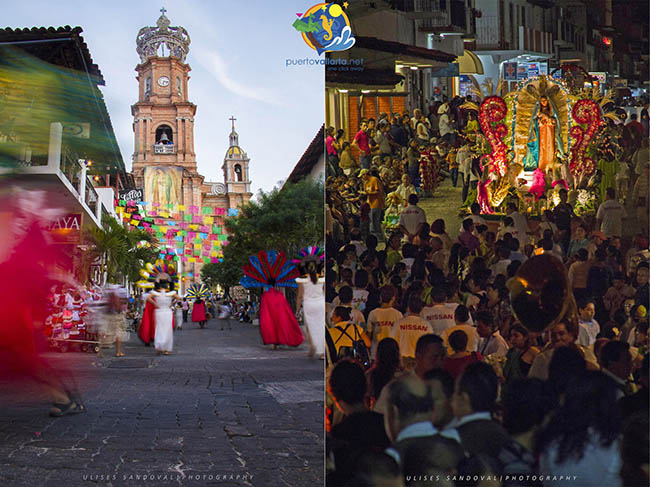Did you know who inspires the iconic crown central Puerto Vallarta downtown? Or who inspired the famous letters of Puerto Vallarta in Malecon?
Parroquia de Nuestra Señora de Guadalupe (Parish of Our Lady of Guadalupe).
During the Spanish conquest, Virgen de Guadalupe's miracle tells that in 1531 Juan Diego, a Mexican Nahuatl indigen saw a vision of the Virgin Mary as a dark skin lady in a simple dress. Her dark hair was covered with a blue cloak with stars.
She asked him in Nahuatl language her wish to build a temple in her honor, in the top of Tepeyac mountain in Mexico City outskirts.
After a few encounters, Juan Diego told the Virgen that the bishop and people in town did not believe him, so Juan Diego's cloak was imprinted with the virgin image in a miracle way.
The Basilica de Guadalupe was built and nowadays is an iconic catholic symbol for Mexican parishioners; Juan Diego's original cloak is in the basilica center in a framework.
 Parish of Our Lady of Guadalupe - Photo by puertovallarta.net
Parish of Our Lady of Guadalupe - Photo by puertovallarta.net
There are Virgen de Guadalupe churches in almost every community along the country.
On December 12, Mexicans celebrate Virgen de Guadalupe.
Processions from all over the country walk from their communities to the Basilica de Guadalupe.
Is a tradition to see Catholics going on their knees, the last kilometers to the Basilica, as a tribute and sacrifice for their sins and needs.
Parroquia de Nuestra Señora de Guadalupe in Puerto Vallarta construction since the beginning of the 20th century is a sample of the city development and national historical events, including an internal Cristian war.

In the beginning, it was a small chapel dedicated to Virgen de Guadalupe. In 1915, church authorities decided to make main modifications to the Chapel to convert it into a tribute to Basilica de Guadalupe. This project started in October 1921.
The Chapel was built during 1930-1940. It is located Infront of City Hall. The building style is a combination of neoclassic and renaissance styles. It has been renovated and modified during the time it has been renovated and modified. The final Basilica was finished in 1965, with a great crown on the top.
 Chapel (1920) - Photo by puertovallarta.net
Chapel (1920) - Photo by puertovallarta.net
There is controversy about the crown design. Some historians claimed it was inspired by Mexican empress Carlota, wife of Maximilian Hapsburg, the emperor of the second empire in Mexico in 1864-1867. The result is a unique, beautiful church constructed in time with a regional style influenced by the Viceroyalty.
The main feature inside is a replica of Juan Diego's cloak with the image of Our Lady of Guadalupe, painted by an artist from Guadalajara city in 1945.
In 1995 the crown fell off by an earthquake with an epicenter in the border state of Colima.
In 2009 was finally replaced with a crown made by the recognized artist from Jalisco Carlos Terres.
Every December 12, you will see a mix of celebration with Cristian and Aztec motifs, people with Aztec customs dancing in the streets, and processions lit by candlelight, mariachis singing the traditional Mexican song for birthdays, “Las Mañanitas.” And this celebration includes mass and local food and Virgen de Guadalupe vendors in the area.
 December 12 celebration - Photo by puertovallarta.net
December 12 celebration - Photo by puertovallarta.net
This October, the Parrish will celebrate its 100th anniversary. Church authorities have planned a year of celebration with musical, religious, sport, and cultural activities.
This Parrish is located on Av. Juarez e Independencia Street, open daily, and offers Catholics English and Spanish mass services.
This church became one of the most distinctive icons of Puerto Vallarta.
International Recognized painter Manuel Lepe 1936-1984
Manuel Lepe was a Puerto Vallarta-recognized artist in the 1960s. His work includes angels, children, and Puerto Vallarta landscapes.
Manuel Lepe started painting at 7 years old, without formal education. His work is inspired by angels, children, and Puerto Vallarta landscapes, including Sierra Madre mountains, rivers, the ocean, and the rural community activities in the region at the time.
This artist is considered a representative within the Naïve art, representing ingenuity in the stroke and spontaneity through bright colors, simplicity, and candor.
Manuel Lepe used to say that he included in his work-art angles because Puerto Vallarta was a paradise; children live without concerns.
You can admire his work a few steps from Nuestra Señora de Guadalupe Parrish in the city hall. The piece “Puerto Vallarta” is an oleo mural located on the second floor.
In the Malecon, in front of the Naval Museum, another of his art pieces is “Fishmongers,” a colorful mosaic mural that is a permanent exhibit for the public.
 “Fishmongers”- By Manuel Lepe - Photo by puertovallarta.net
“Fishmongers”- By Manuel Lepe - Photo by puertovallarta.net
Also, the iconic letters of Puerto Vallarta, first in Puerto Vallarta Malecon, and nowadays in every tourist destination, including magic towns, are inspired in his artwork.
 Inspired by the art of Manuel Lepe - Photo by puertovallarta.net
Inspired by the art of Manuel Lepe - Photo by puertovallarta.net
His work is also exhibited at the Royal Mews Museum at Windsor Castle, among other important art galleries manlily in The United States. He also is included in the French directory of Painters of the Century.
UNICEF, the United Nations agency created in 1946 to protect children in Europe and China after Second World War. Today this agency keeps protecting children's rights over the world.
Because of the innocence of his art, Manuel Lepe collections were chosen several times by UNICEF to represent children in cards that the organization sells for funding.
April 17th is the official day for commemorating this marvelous artist.
There is a Gallery in Puerto Vallarta with Manuel Lepe Gallery pieces, Casa Museo Manuel Lepe located in the romantic zone, but is temporally closed.


